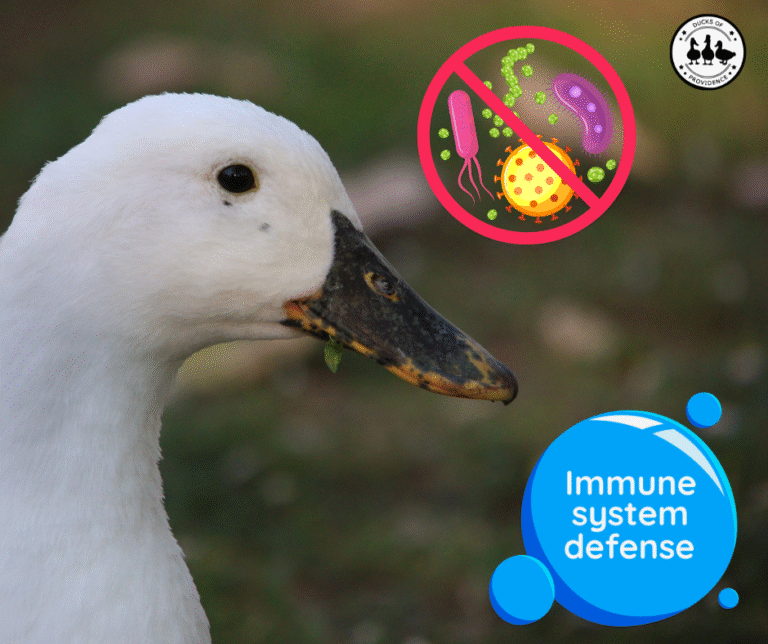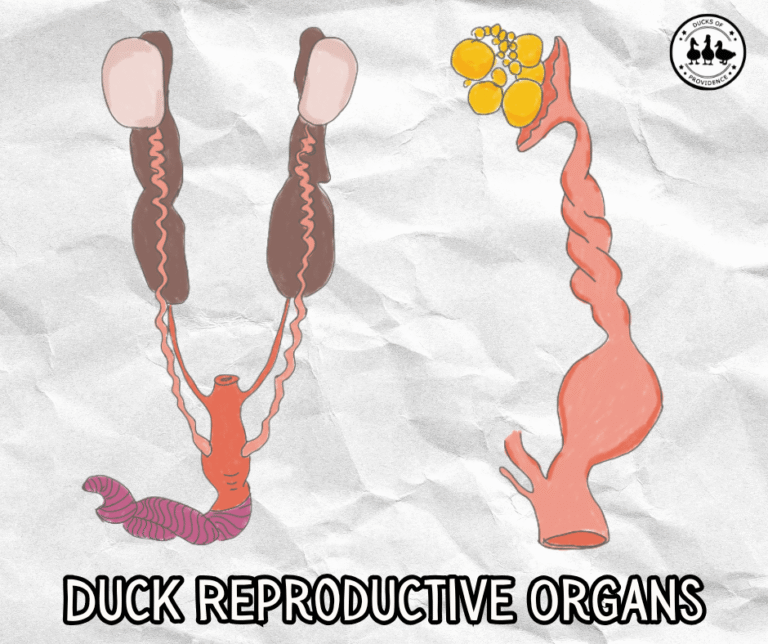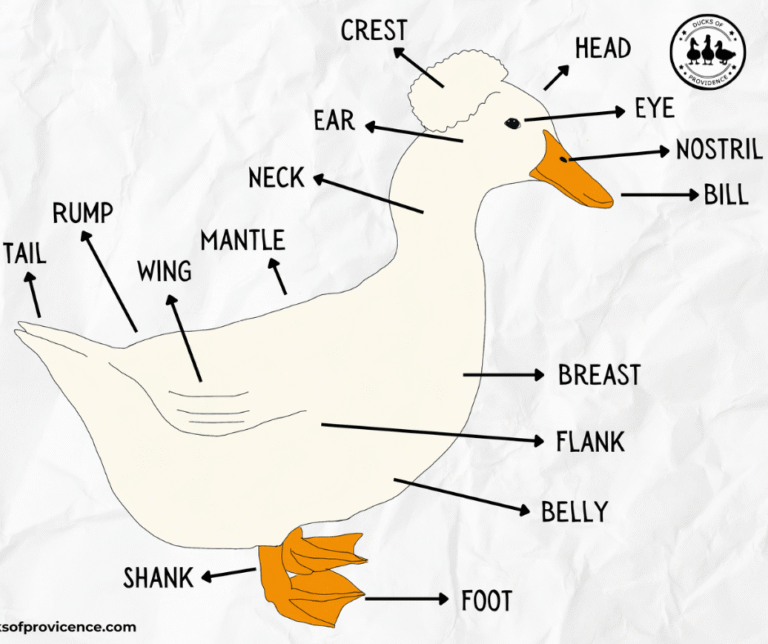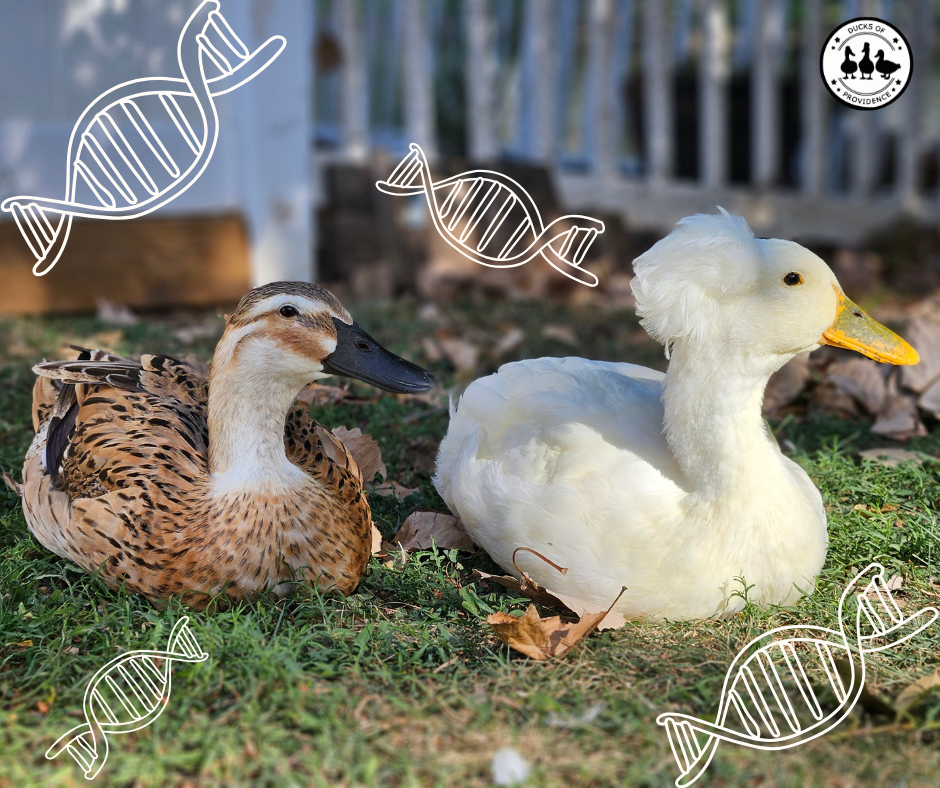
Color Genetics in Ducks: Why Are Some Ducklings a Surprise?
Have you ever had a duckling hatch with a completely unexpected color? Maybe you were sure you’d get another yellow fluffball, and instead out popped a dark chocolate duckling or one with wild speckles you’ve never seen before. If so, you’re not alone—and you’ve just experienced the wonderful unpredictability of color genetics in ducks.
As pet duck keepers, we often assume that our ducklings will look like their parents. But in reality, duck coloration is determined by a complex mix of genes, many of which can remain hidden for generations before reappearing. Just like human children can inherit Grandpa’s red hair or Aunt Lucy’s dimples, ducklings can carry genetic surprises from ancestors you’ve never seen.
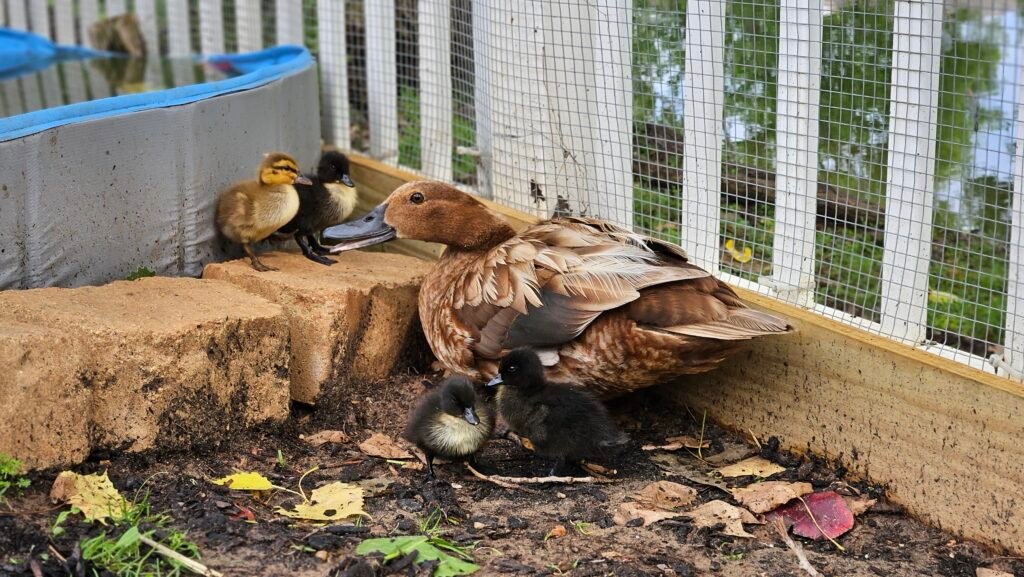
In this post, we’ll explore the basics of how duck color genetics work, what makes ducklings such a genetic grab bag, and why some combinations result in colors and patterns that seem to come out of nowhere. Whether you have a mixed flock of backyard ducks or you’re trying to breed specific traits, understanding the science behind duck coloration can help you appreciate the beauty—and biology—behind every feather.
Ducks of Providence is free, thanks to reader support! Ads and affiliate links help us cover costs—if you shop through our links, we may earn a small commission at no extra cost to you. Thanks for helping keep our content free and our ducks happy! 🦆 Learn more
Basics of Duck Genetics
Understanding duck color genetics starts with some basic biology. Every living organism—including ducks—has a unique set of DNA, the genetic material that acts like a blueprint for how their body is built and functions. DNA is packaged into structures called chromosomes, and each gene sits at a specific location on a chromosome.
Ducks, like other birds, have 80 chromosomes in total, arranged in 40 pairs. This includes both autosomes (which carry most of the genetic instructions, including those for feather color) and sex chromosomes, which determine whether a duck is male or female.
In birds, sex chromosomes work differently than in mammals:
- Female ducks have Z and W chromosomes (ZW)
- Male ducks have two Z chromosomes (ZZ)
This system means that females are the heterogametic sex—they determine the sex of the offspring, and certain color genes that are located on the Z chromosome can be sex-linked, affecting how traits are inherited in sons vs. daughters.
Now, when it comes to regular (autosomal) color genes, every duck still inherits two copies of each gene—one from the mother and one from the father. These different versions of a gene are called alleles.
- A dominant allele will mask the effect of a recessive one. If a duck inherits a dominant color gene from either parent, that trait usually shows up in its appearance.
- A recessive allele must be inherited from both parents to show up in the duck’s appearance.
This is why duck coloration isn’t always straightforward. A duck might appear solid black, chocolate brown, or white on the outside (its phenotype), but still carry hidden color genes (its genotype) that can reappear in later generations.
Genetics 101: Key Terms to Know
Locus (plural: loci):
The specific location of a gene on a chromosome is like a home address for where a particular trait is controlled. For example, the E locus controls black coloring in feathers.
Allele:
A version of a gene. Every duck inherits one allele from each parent. Some alleles are dominant (they show up even if there’s only one copy), while others are recessive (they only show up if there are two copies).
Genotype:
The genetic code a duck carries—even the parts you can’t see. A duck may look white on the outside but still carry genes for black, chocolate, or bibbed patterns.
Phenotype:
What you actually see are the visible traits like feather color, pattern, posture, or crest. It’s the result of the duck’s genotype plus environmental influences like nutrition and stress.
Let’s Talk Inheritance
Ducklings receive 50% of their genes from each parent. Which genes get passed down is completely random, which is why a single clutch of ducklings can display such variety, even with the same mom and dad. If you’ve ever seen one yellow duckling, one black, and one patterned one hatch from the same nest, you’ve seen this randomness in action.
Dominant, Recessive, and Incomplete Dominance
Here are the three common inheritance patterns that matter in duck coloration:
- Dominant Inheritance
Example: The Extended Black (E) gene is dominant. If a duck inherits even one E allele, it usually shows solid black coloring, often with iridescent green or blue tones. - Recessive Inheritance
Example: The chocolate gene is recessive. Ducks must inherit two chocolate alleles (one from each parent) to appear brown. - Incomplete Dominance
Example: The Blue dilution (Bl) gene. One copy creates a blue duck; two copies produce a splashy light gray-white duck; zero copies result in a black duck. This is why blue × blue matings produce blue, black, and splash ducklings in a predictable 1:2:1 ratio.
This type of inheritance follows what we call Mendelian genetics, based on the work of 19th-century scientist Gregor Mendel. Although originally studied in pea plants, these principles apply across species, including waterfowl.
📌 Pro-Tip: Even if two ducks look identical, their genetic makeup may be completely different. That’s why a duck that looks like a pure white Pekin could be carrying hidden genes from a black Swedish ancestor!
Genotype vs. Phenotype in Practice
- Genotype: The actual combination of alleles a duck has (even the hidden ones)
- Phenotype: The visible traits, like feather color, markings, or bill shade
So, a duck with one dominant white allele and one recessive color allele will appear white, but might pass on the hidden color to its offspring. This is how surprising duckling colors can pop up even in well-established flocks.
Capital vs. Lowercase Letters
In genetic notation:
- Capital letters usually represent dominant alleles
- Lowercase letters usually represent recessive alleles
Example: Extended Black gene (E locus):
- E = dominant allele for extended black (black coloring overrides other patterns)
- e+ = wild-type allele (mallard pattern), recessive to E
A duck with:
- E/E will be solid black
- E/e+ will still be black (because E is dominant)
- e+/e+ will show the mallard pattern (only if no dominant E is present)
📌 Capital = Dominant, Lowercase = Recessive
What does the “plus sign” mean?
The plus sign (+) is often used to represent the **wild-type
What Is a Locus in Genetics?
In genetics, a locus (plural: loci) is simply the specific physical location of a gene on a chromosome.
You can think of a locus like a street address for a gene. Each gene has its own fixed spot along the length of a chromosome. While every duck has the same set of chromosomes, what varies is which alleles (versions of a gene) they carry at each locus.
Example in Ducks
Let’s say there’s a gene that affects feather color, like the Extended Black gene (symbol E):
- The E locus is the location on the chromosome where this color gene is found.
- The alleles at this locus might be:
- E = Extended black (dominant)
- e+ = Wild-type/mallard pattern (recessive)
A duck will have two alleles at each locus—one inherited from each parent. So at the E locus, a duck might have:
- E/E (homozygous black)
- E/e+ (still black, because E is dominant)
- e+/e+ (shows wild-type pattern)
Why Is This Important?
Understanding loci helps explain:
- Where on the chromosome are specific traits controlled
- How different traits are inherited together (if the loci are close together)
- Why are some traits (like feather color, spotting, or size) controlled by multiple loci, not just one
For duck color genetics, researchers and breeders often refer to:
- The E locus (Extended Black)
- The Bl locus (Blue dilution)
- The C locus (Color suppression, including recessive white)
- And others like the bibbing, pied, and harlequin loci
Each one refers to a specific spot on the duck’s genome that influences a trait.
Common Color Genes in Domestic Ducks
When it comes to duck coloration, a handful of key genes play a major role in shaping what we see in both ducklings and adults. Most of these genes control things like pigment production, pattern distribution, or dilution effects (how strong or muted the colors are). Understanding these can help explain why your ducklings hatch in a surprising range of colors, even if the parents look fairly standard.
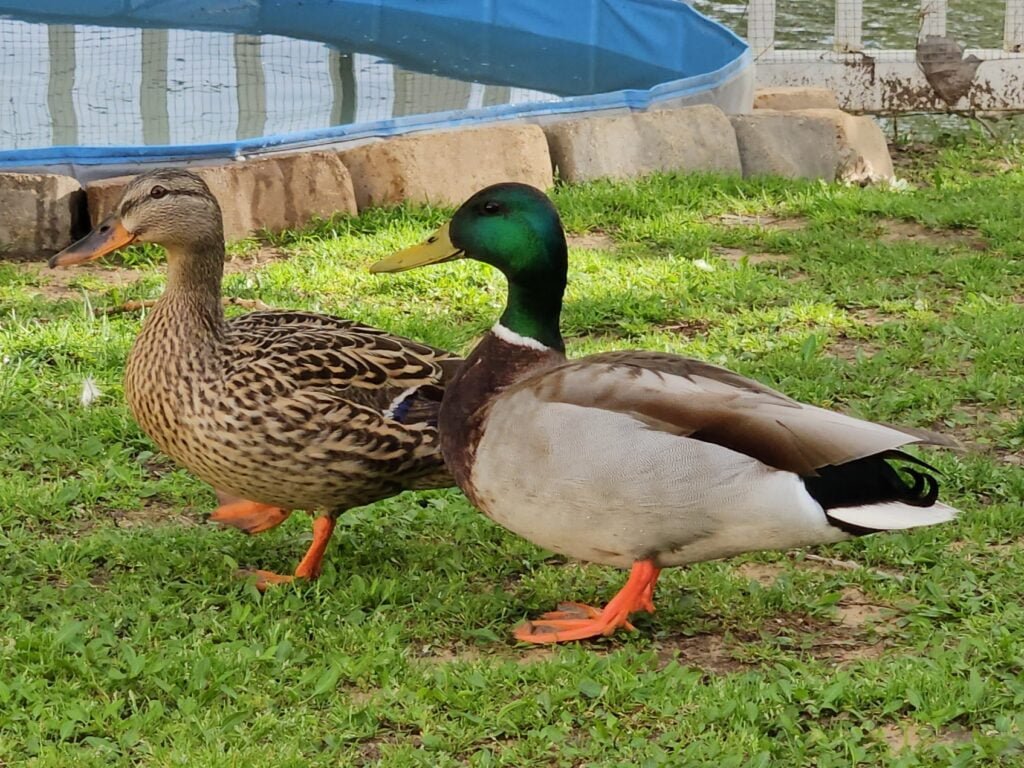
It’s important to note that most domestic duck breeds (except Muscovy) are descended from the Mallard (Anas platyrhynchos), and they share a common genetic toolkit. The diversity we see today—from the glossy black Cayuga to the white Pekin—is due to centuries of selective breeding and gene mixing.
Let’s explore the most common color genes found in domestic ducks:
Key Color Genes and Their Effects
| Gene Name | Symbol | Effect on Plumage | Breeds It’s Common In | Type of Inheritance |
|---|---|---|---|---|
| Extended Black | E | Solid black feathers; can mask underlying patterns | Cayuga, Black Swedish, Black Runner | Dominant |
| Blue Dilution | Bl | One copy = Blue; Two = Splash; None = Black | Blue Swedish, Blue Runner | Incomplete Dominance |
| Chocolate | choc | Rich brown feathering; often with lighter bills/feet | Khaki Campbell, Chocolate Runner | Recessive |
| Dusky | d | Removes mallard-style chest bars and patterns | Rouen, certain Mallard mixes | Recessive |
| Recessive White | c | Removes visible pigment (leucism), giving full white plumage | Pekin, White Crested | Recessive |
| Bibbed | b | White bib or chest patch on colored body | Magpie, Swedish, Ancona | Likely dominant or codominant |
| Pied/Spotting | s | Random white patches or pied pattern | Ancona, Magpie | Incomplete dominance or polygenic |
| Harlequin Phase | li | Softens mallard pattern; adds lacing/creaminess | Welsh Harlequin | Complex (likely polygenic) |
| Crele/Light Phase | li+ | More muted mallard pattern with lighter base color | Saxony, Silver Appleyard | Likely polygenic |
How These Genes Interact
- Extended Black (E) tends to override other genes. Even if a duck carries genes for mallard patterning or blue dilution, the E gene can turn the bird almost fully black.
- The Blue dilution (Bl) gene is a classic example of incomplete dominance:
- Black × Black = all black ducklings
- Blue × Blue = 25% black, 50% blue, 25% splash
- Blue × Black = 50% blue, 50% black
- The Chocolate gene is sex-linked in some lines of ducks, meaning it may be passed more easily through one parent (usually the drake), depending on chromosome pairing.
- Pied/spotting genes are influenced by multiple loci, which makes them hard to predict. This is why ducks like Anconas often have completely unique markings, even within the same clutch.
Why Two Ducks of the Same Color Can Produce Unexpected Ducklings
Let’s say you have two Blue Swedish ducks. If they both carry the Bl gene, and you breed them together, not all the ducklings will be blue—some will be black, and some will be splash (a lighter, almost marbled color with random white patches).
Similarly, if you cross a Cayuga (E/E) with a duck carrying recessive genes like chocolate or bibbed, you may not see those traits in the first generation, but they can pop up in the next if the offspring are paired correctly.
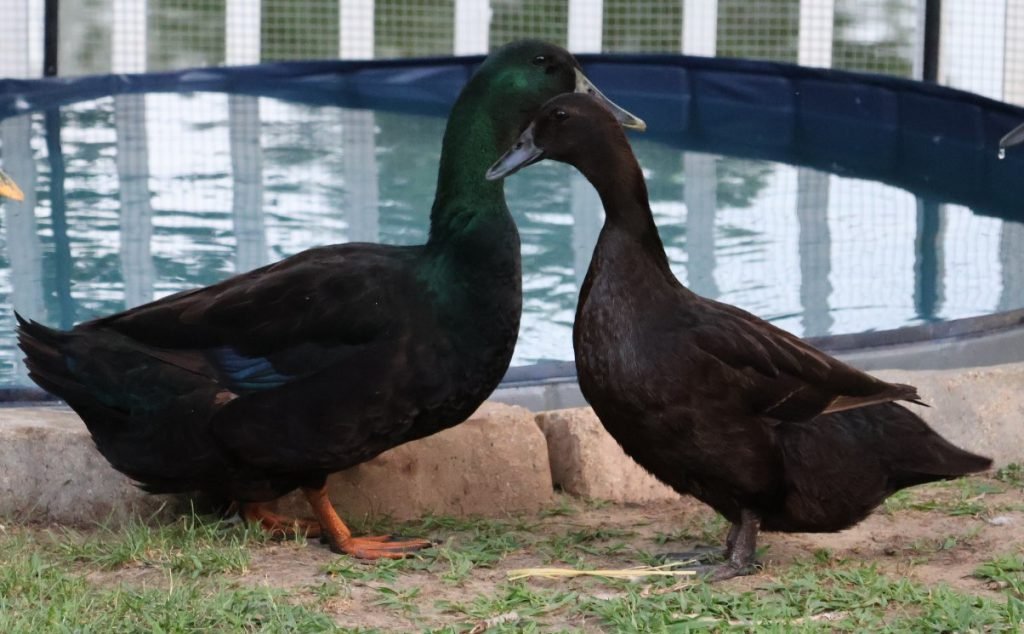
📌 Pro-Tip: Keep track of your ducks’ parentage if you’re breeding. Knowing who carries which genes helps you avoid surprises—or plan for them!
In the next section, we’ll explore exactly why ducklings from the same parents can come in so many different colors and patterns, even when those parents look identical.
Why Ducklings Can Be a Genetic Grab Bag
So you’ve got two ducks that look nearly identical—and yet their ducklings hatch in completely different colors. What’s going on?
The answer lies in the hidden complexity of duck genetics. While we might only see the phenotype (the visible traits), each duck carries a genotype—a set of genes passed down from its ancestors. Many of these genes can be recessive or influenced by incomplete dominance, meaning they don’t always show up in the parents but can reappear in the offspring when the right genetic combination comes together.
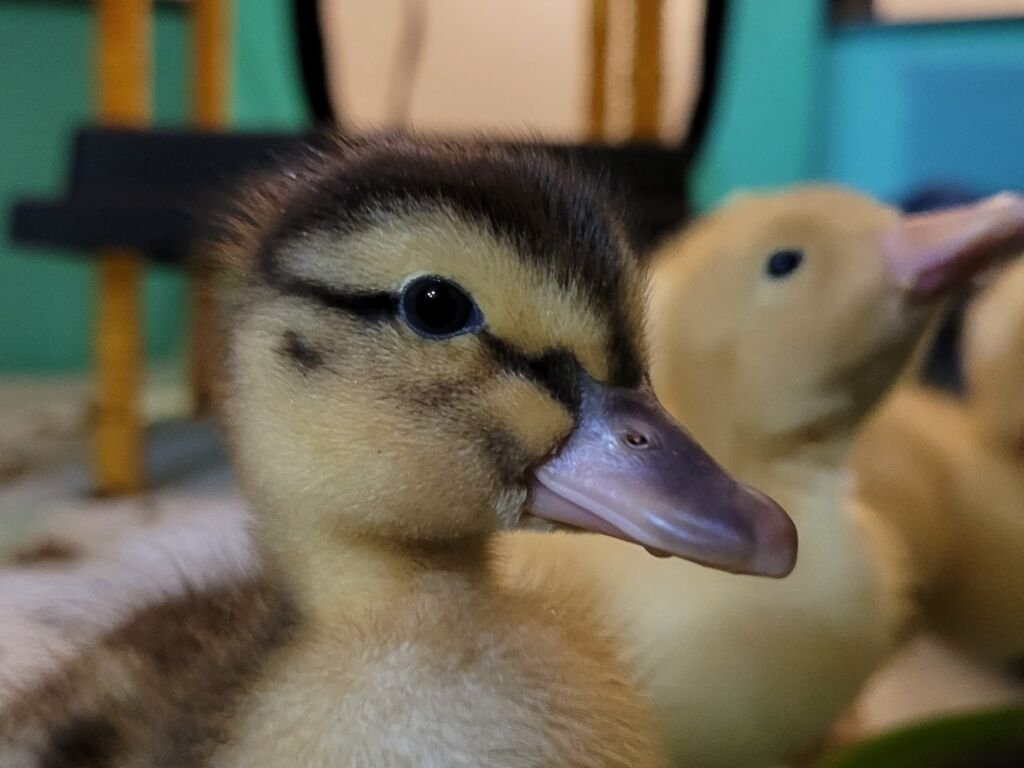
The Genetic Lottery
When two ducks mate, each parent randomly passes down one allele from each gene pair. That means for every color gene, there’s a 50/50 chance for each allele to be inherited. When you consider the number of color-related genes involved, it’s no wonder ducklings can turn out to be a delightful surprise.
Here’s a simplified example using the Blue dilution (Bl) gene, which follows an incomplete dominance pattern:
Blue Dilution Gene Example (Punnett Square)
Parent Genotypes:
Both ducks are Bl/bl (heterozygous = blue feathered)
| Bl (Blue allele) | bl (no dilution) | |
|---|---|---|
| Bl | Bl/Bl (Splash) | Bl/bl (Blue) |
| bl | Bl/bl (Blue) | bl/bl (Black) |
Offspring Outcome:
- 25% Splash (Bl/Bl)
- 50% Blue (Bl/bl)
- 25% Black (bl/bl)
So even if both parents are blue, only half the ducklings will match them. The rest might be lighter or darker, and this principle applies to other genes as well.
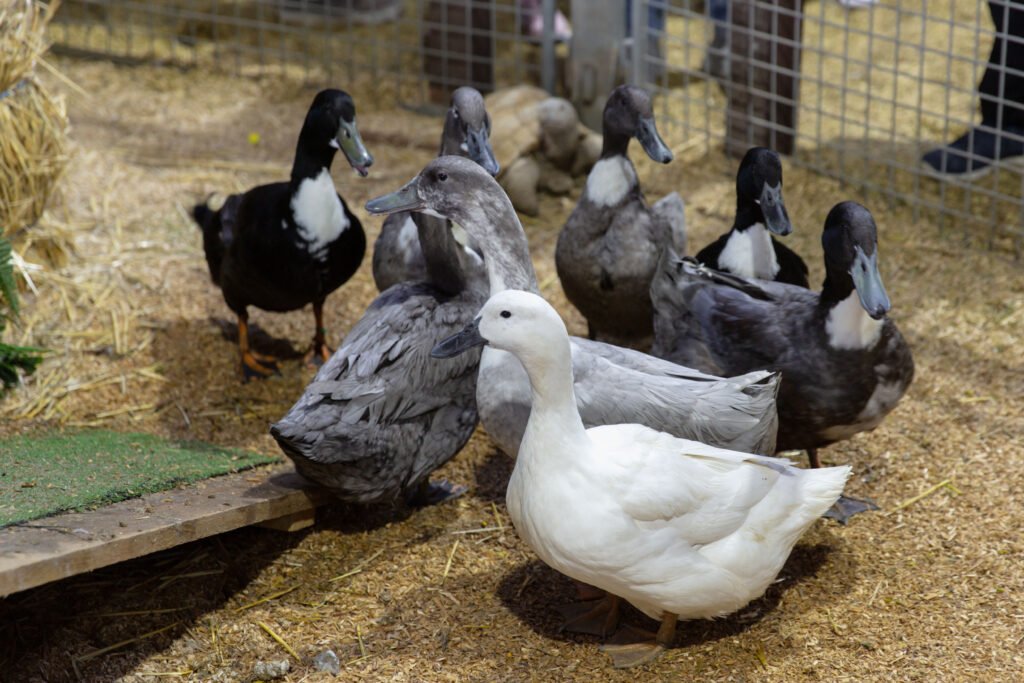
When Recessive Genes Reappear
Imagine both your ducks carry a recessive gene for chocolate (even if they don’t look brown themselves). If each parent passes down the chocolate allele, the duckling will display that color.
It’s like hidden family traits in humans: two brown-eyed parents can occasionally have a blue-eyed child if they both carry the recessive gene for blue eyes. Ducks work the same way!
Multiple Genes, More Combinations
Most duck colors and patterns are not determined by just one gene. Instead, they’re influenced by multiple loci (places on the DNA) working together, or even modifying each other. A duck might have:
- A color gene (like black or chocolate)
- A pattern gene (like bibbed or pied)
- A dilution gene (like blue)
- A modifier gene (like dusky)
These can combine in different ways, leading to a wide variety of visual outcomes—even within a single clutch of eggs.
📌 Pro-Tip: If your flock includes mixed breeds or rescue ducks with unknown parentage, expect the unexpected. Surprise ducklings are often the result of generations of hidden gene combinations.
In the next section, we’ll look at how different breeds affect these outcomes, and which ones are more likely to produce a colorful clutch of ducklings.
Influence of Breed-Specific Traits
Not all duck breeds are created equal when it comes to color genetics. Some breeds were developed for consistent, predictable appearances, while others are famous for their variety and surprises. This means that the breed (or mix of breeds) in your flock plays a big role in how your ducklings will look.
Whether you’re keeping purebred lines or a diverse backyard flock, knowing how color genetics express within each breed can help you make sense of your ducklings’ unexpected colors.
Breeds with Predictable Coloration
Certain breeds were selectively bred to have very consistent plumage, making them more reliable if you’re trying to predict the look of your ducklings.
- Pekin Ducks
- Usually carry recessive white genes, resulting in solid white ducklings.
- Their genetic background is often limited in variety, especially in production lines.
- Khaki Campbells
- Their signature khaki-brown color is the result of specific combinations of chocolate and dusky genes.
- Breeding two Khakis together will usually produce more Khaki ducklings, assuming a pure genetic line.
- Cayuga Ducks
- Known for their iridescent black plumage, often due to the Extended Black (E) gene.
- Cayugas may carry other genes that are masked by E, which could show up in mixed pairings.
- Indian Runners (standard colors)
- When bred true to a variety (e.g., fawn & white, black, chocolate), they typically pass down consistent colors.
- But crossing different varieties or introducing mixed lines can open the door to surprises.

Breeds with High Color Variety
Some duck breeds were intentionally developed or preserved for multicolored, mottled, or patterned plumage, making their offspring more genetically diverse.
- Ancona Ducks
- Their characteristic spotted pattern is due to pied genes, often polygenic (influenced by multiple genes).
- Each Ancona duck has a unique pattern—even siblings from the same clutch can look completely different.
- Magpie Ducks
- Similar to Anconas but with more structured black-and-white markings, especially on the head and back.
- They may carry recessive spotting or bib genes that can cause unusual markings in cross-breeds.
- Welsh Harlequins
- These ducks exhibit the harlequin phase—a soft, laced pattern that’s influenced by both sex and age.
- Drakes and hens have distinct plumage, and color can shift with molt.
- Silver Appleyards & Saxony Ducks
- These dual-purpose heritage breeds were developed for both size and beautiful, subtly patterned feathering.
- Their coloration can vary with age and gender, especially in mixed flocks.
The Role of Sex-Linked Traits
Some color genes are sex-linked, meaning they are found on the Z or W sex chromosomes in birds (unlike mammals, birds have ZW females and ZZ males). This can result in:
- Only males displaying certain traits
- Auto-sexing offspring in some hybrids (common in sex-linked production ducks)
For example, in some strains of chocolate-colored ducks, the chocolate gene is sex-linked, meaning it’s more reliably passed down through the male line and affects daughters differently than sons.
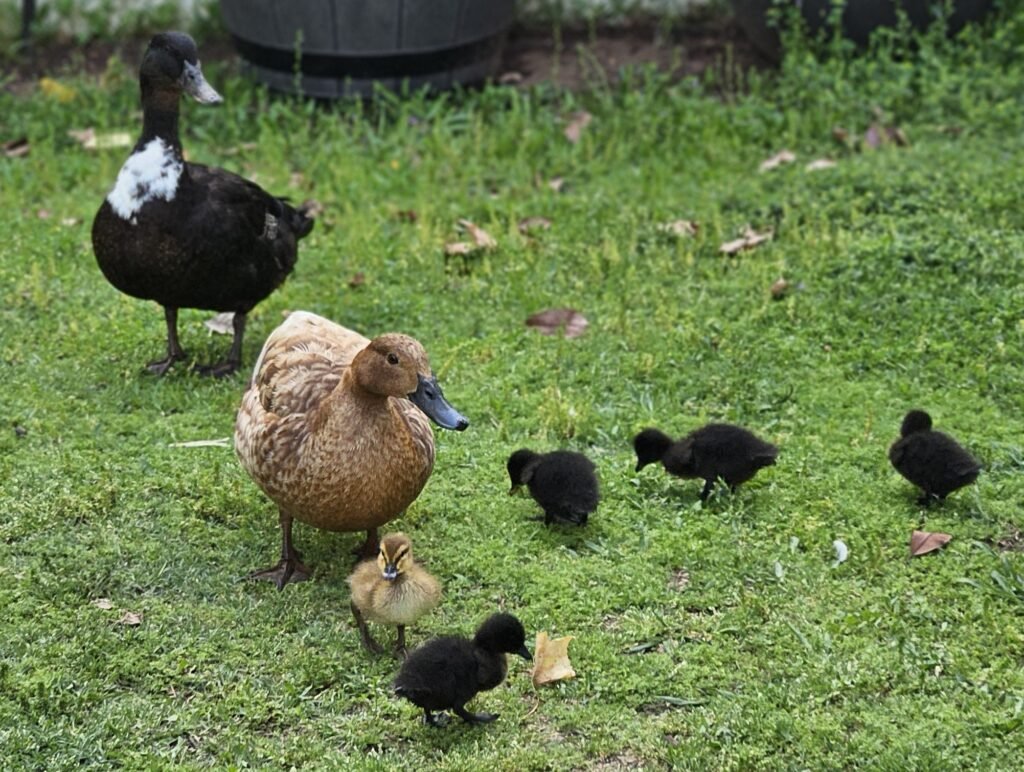
Cross-Breeds: The Genetic Wild Card
If your flock includes ducks of different breeds—or hybrids—the genetic possibilities multiply quickly. Mixed-breed ducks often carry several invisible recessive genes, and when crossed with other carriers, the results can be:
- Surprising new colors (e.g., blue bibbed ducklings from a Cayuga × Swedish mix)
- Unexpected patterns (e.g., speckling, lacing, or bibbing)
- Offspring that don’t resemble either parent at first glance
📌 Pro-Tip: Keep notes on your pairings and duckling outcomes if you’re curious about inheritance patterns. Over time, you may start to decode the genetic puzzle in your flock.
Up next: we’ll explore how feather patterns and markings—from bibs to speckles—are controlled by a different set of genes, and why some ducklings lose or gain patterns as they grow.
Mixed Breed vs. Hybrid Ducks: What’s the Difference?
While both terms describe ducks with parents from different backgrounds, the key difference lies in species vs. breed.
Mixed Breed (Same Species, Different Breeds)
- Definition: A duck that has parents from two different breeds within the same species.
- For most domestic ducks, this means both parents are Anas platyrhynchos domesticus (descended from the Mallard).
- These ducks can vary widely in appearance, depending on the combination of inherited genes, but they are still fully fertile and genetically compatible.
Examples of mixed-breed pairings:
- Cayuga × Pekin
- Khaki Campbell × Blue Swedish
- Indian Runner × Ancona
Result: Mixed-breed ducks often inherit a blend of color, pattern, body shape, and temperament from both parents. Offspring are fertile and can be bred again.
Hybrid (Different Species Crossed)
- Definition: A duck that is the result of a cross between two different species, most commonly:
- Muscovy (Cairina moschata) × a domestic duck (Anas platyrhynchos domesticus)
- These ducks are technically interspecies hybrids. While they may look similar to other ducks, they are not genetically compatible in the same way.
Example:
- Muscovy drake × Pekin hen
- Resulting duckling is a mule duck or mulard (depending on the line)
Key Traits of Hybrids:
- Often sterile (especially the males)
- May have unusual physical features or temperaments
- Common in commercial meat production (especially Muscovy hybrids)
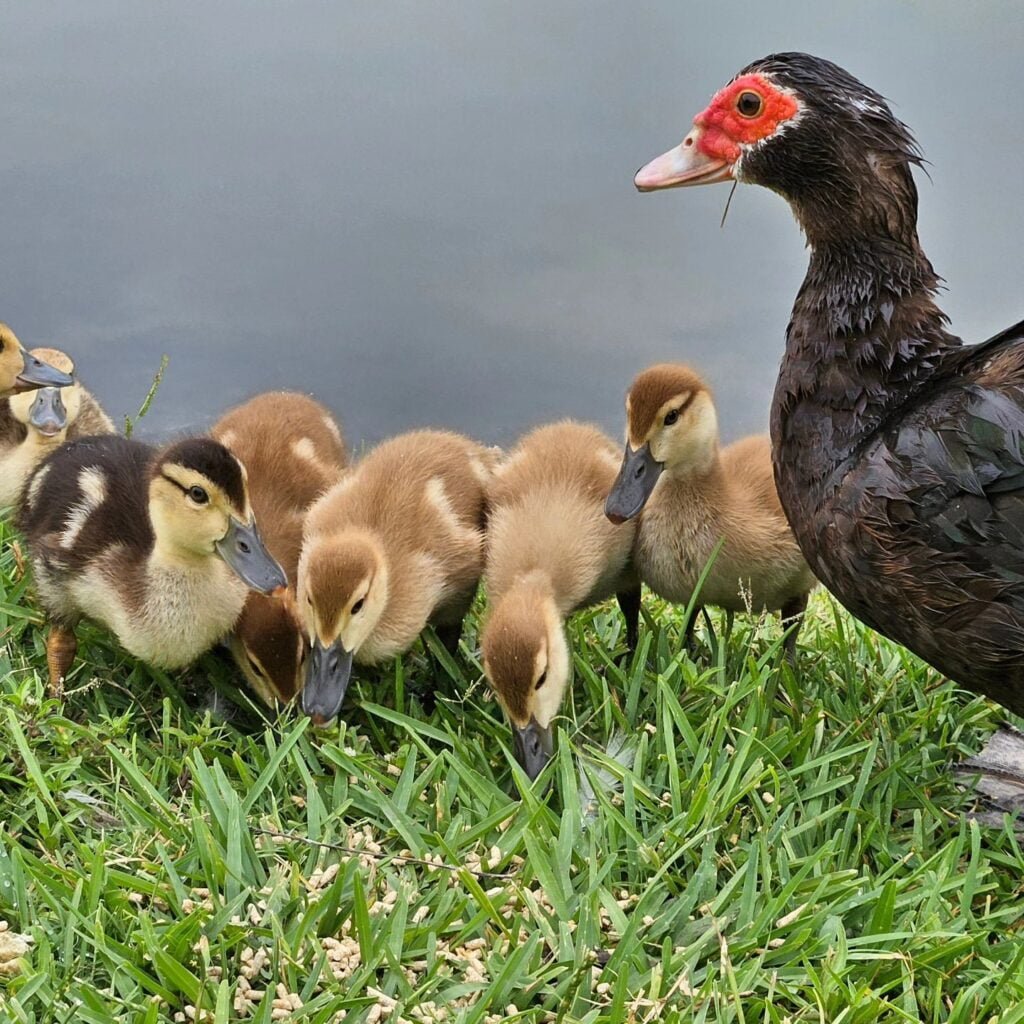
Important Note for Pet Duck Owners
- Mixed-breed ducks are common in backyard flocks and bring a delightful variety.
- Hybrids, on the other hand, require more consideration, especially because:
- You won’t be able to breed from them successfully.
- They may have unique care needs or behavioral differences (e.g., part-Muscovy hybrids may be quieter but more flighty).
Not Just Color: Patterns and Markings
While color genes determine the base hue of your duck’s feathers—black, chocolate, blue, white, etc.—pattern and marking genes influence how that color appears on the body. Think of it like painting a duck: the color gene is the paint, and the pattern gene is the brushstroke.
Just like in dogs or cats, duck feather patterns are controlled by separate genetic pathways and can vary even among ducklings that share the same base color.
Common Duck Feather Patterns and Markings
| Pattern/Marking | Description | Common in Breeds |
|---|---|---|
| Bibbed | White chest patch on a colored body | Swedish, Magpie, Ancona |
| Pied/Patchy | Random white patches throughout the body | Ancona, Magpie, hybrids |
| Lacing | Each feather edged in a different color | Silver Appleyard, Saxony |
| Barred/Striped | Repeating stripes across feathers | Muscovy, Mallard hens |
| Mottled | Irregular speckling, especially on the chest or face | Older Cayugas, hybrids |
| Mallard Pattern | Distinctive wild-type markings: eye stripe, chest bar, and speculum | Mallards, Rouens, Runners |
| Harlequin Phase | Creamy, softened version of mallard pattern with diluted tones | Welsh Harlequin |
How Pattern Genes Work
Some pattern genes are dominant, while others may be polygenic, meaning influenced by multiple genes. For instance:
- The bibbed gene appears to act as a dominant trait, meaning a duck only needs one copy to show a white chest patch. However, the size and shape of the bib can vary widely.
- Pied/spotting patterns tend to be less predictable. The placement and amount of white are likely controlled by multiple genes—and even environmental factors may play a minor role in expression.
- Mallard patterning is considered the wild-type base, and most ducks carry it unless it’s masked by genes like Extended Black (E) or White. When unmasked, it gives drakes their colorful heads, chestnut breasts, and curly tail feathers.
Ducklings vs. Adult Patterns
Ducklings often don’t show their final feather patterns right away. A duckling that appears solid dark may later develop lacing, bibbing, or spotting as it molts into juvenile and adult plumage. Some changes include:
- Disappearing bibs: Some bibs fade or shift with molt, especially in mixed-breed ducks.
- Mottling with age: Cayugas, for example, may develop white mottling as they age—even if they were solid black as ducklings.
- Sexual dimorphism: In mallard-patterned breeds, males and females often look completely different as adults. Female Saxony and Silver Appleyard ducks are more muted, while males display bolder patterns and colors.
📌 Pro-Tip: Don’t judge a duckling’s final appearance too early! Their full feathering can take weeks to emerge, and some surprises only appear after their first molt.
In the next section, we’ll look at Muscovy ducks specifically. Because they belong to a completely different species, their color and pattern genetics follow a different set of rules.
Muscovy Genetics: A Different Species, a Different Puzzle
While most domestic ducks kept as pets or for eggs and meat are derived from the Mallard (Anas platyrhynchos domesticus), the Muscovy duck is something else entirely. It belongs to a different species: Cairina moschata. This biological difference is important—not only do Muscovies look and act differently, but their color genetics follow a separate playbook.
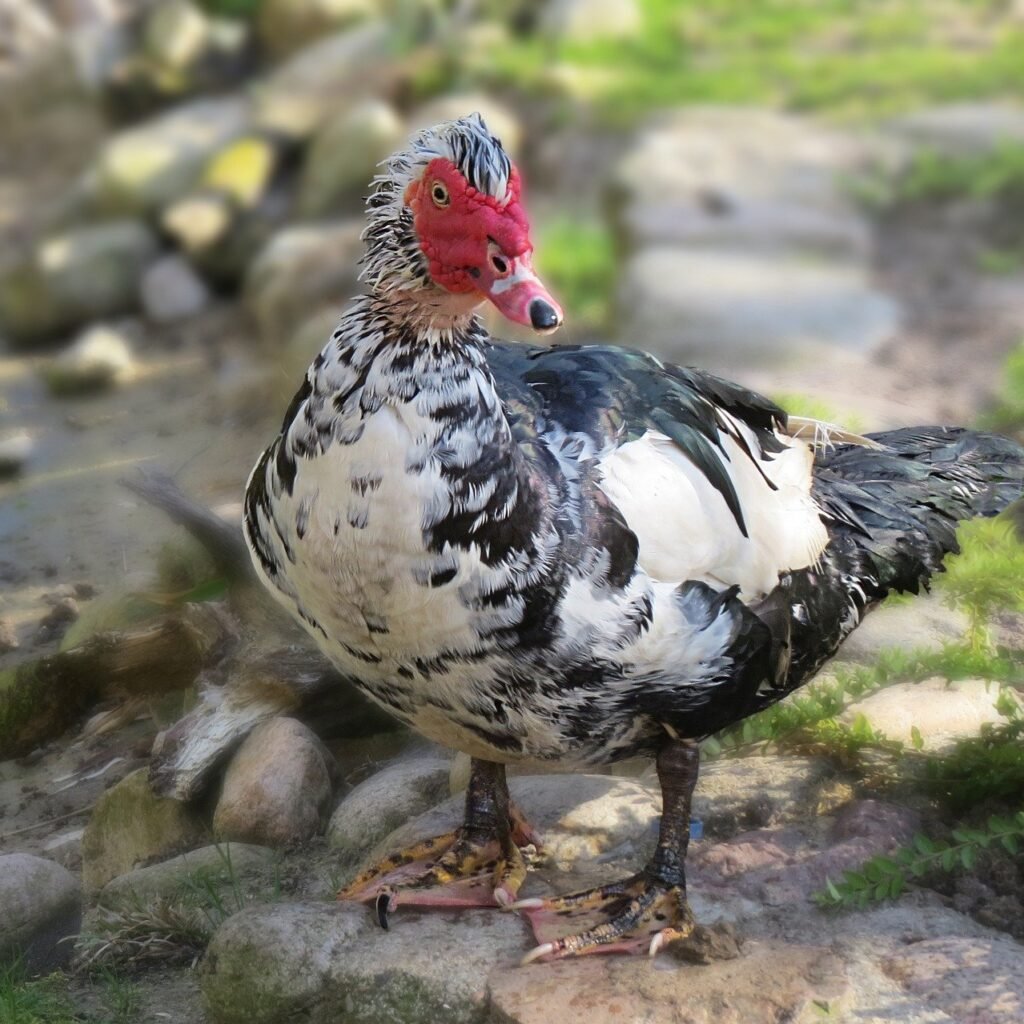
Different Species = Different Genetic Rules
Because Muscovies are not closely related to Mallard-derived breeds, they don’t share the same gene pool. That means the common color genes like Extended Black, Blue dilution (Bl), or Dusky (d) aren’t found in Muscovies. Instead, they have their own unique set of color and pattern traits, and breeders have developed several beautiful varieties using completely different genetic mechanisms.
Common Muscovy Colorations and Patterns
| Color/Pattern | Description | Notes |
|---|---|---|
| White | Pure white plumage | Common in meat production lines; not from the same “white gene” as Pekins |
| Black | Iridescent black feathers | Base color in many wild-type Muscovies |
| Blue | Diluted black with gray-blue sheen | Result of a separate dilution gene, not the same as Mallard-derived blue |
| Chocolate | Deep brown plumage | Recessive trait, behaves similarly to chocolate in Mallards but genetically distinct |
| Lavender | Random white patches ona colored body | Often produced through combining chocolate and blue genes |
| Pied (White Patch) | Random white patches on a colored body | Controlled by separate spotting genes |
| Barred | Feather pattern with horizontal stripes | Unique to Muscovies, especially in drakes |
| Bronze, Ripple, Silver, Opal | Specialty varieties from selective breeding | Often polygenic, less predictable outcomes |
📌 Pro-Tip: If you keep both Mallard-derived ducks and Muscovies, it’s important to understand they are not genetically interchangeable when it comes to coloration or breeding.
What About Muscovy Hybrids?
If you cross a Muscovy with a Mallard-derived duck (like a Pekin, Runner, or Cayuga), the resulting offspring are called mule ducks (or mulards, especially in France). These hybrids:
- Are interspecies crosses
- Are almost always sterile, especially the males
- Often display mixed physical traits, such as partial caruncles (the red facial growths of Muscovies), unique vocalizations, or intermediate body shapes
- May have unpredictable and often muddy feather coloring
Mule ducks are common in the commercial meat industry because they combine the growth rate of Pekins with the leaner meat and calm temperament of Muscovies—but they’re not a great option for backyard breeding, since you won’t be able to continue the line.
Muscovy Care Tip
If you’re raising Muscovies alongside other ducks:
- Be cautious of mating behavior—Muscovy drakes are often much larger and more persistent.
- Be aware of their flight capability: Muscovies are excellent fliers unless clipped or kept in a covered aviary.
Up next, we’ll look at how duck color can continue to change with age, sex, and seasonal molts—and why that “cute yellow duckling” may look completely different in just a few months.
Color Changes with Age and Molting
Ducklings are rarely born looking like their adult selves. In fact, the transformation from soft fluffball to fully feathered adult can include some dramatic changes—not just in size, but in color, pattern, and even feather structure.
If you’ve ever raised a yellow duckling that turned brown, or a striped baby that molted into a solid-colored adult, you’ve witnessed this firsthand. These changes are normal, genetically programmed stages in a duck’s development, and they continue throughout the duck’s life.
From Hatchling to Juvenile: First Feathers, First Surprises
Most ducklings hatch with down feathers, which are soft and lack the structure of adult plumage. These baby feathers often give no clear indication of the adult bird’s final appearance.
- Yellow ducklings (like Pekins or white Runners) will usually grow in white feathers.
- Dark ducklings might turn out black, chocolate, or blue depending on their genes.
- Mallard-patterned ducklings have eye stripes and brown fuzz that gradually develop into the familiar wild-type look, but even that can shift with age and sex.
This first transformation usually happens between 3–6 weeks of age, when ducklings start to grow juvenile feathers. This is the first major molt and often reveals new colors and patterns.
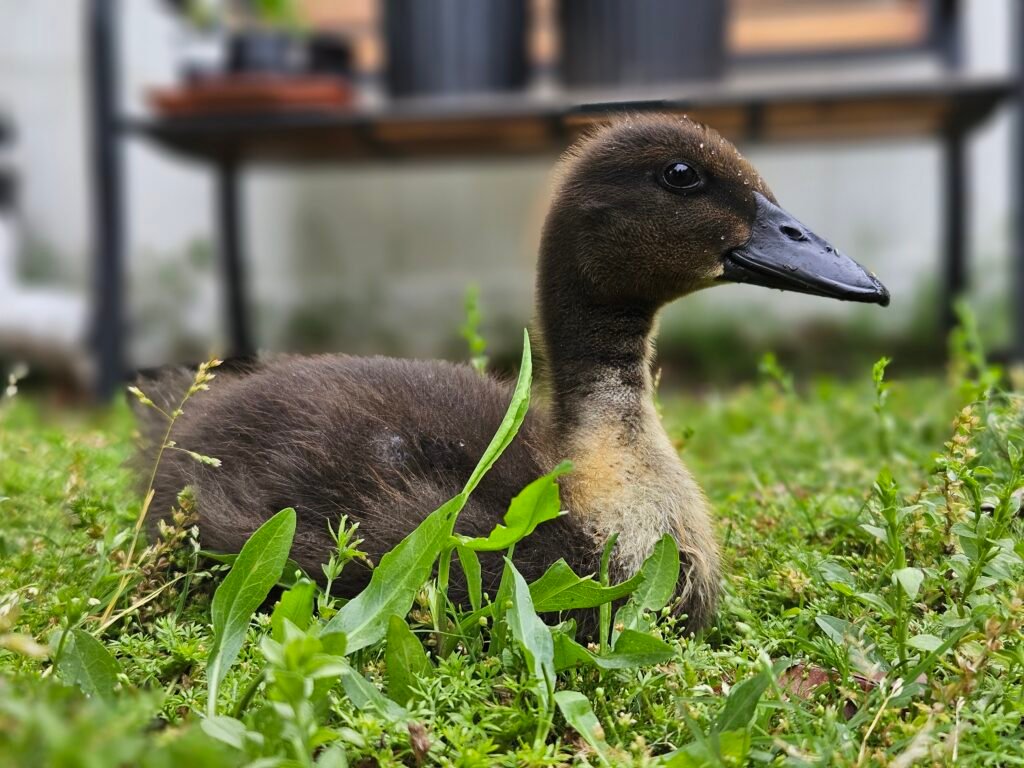
Juvenile to Adult: Final Feathering and Sexual Dimorphism
At around 12–16 weeks, ducks go through a second, more significant molt that brings in their adult plumage. This stage can change:
- Color intensity
- Feather lacing or edging
- Sex-specific traits, like iridescence in drakes or subtle tone changes in hens
In Mallard-derived breeds, this is when sexual dimorphism really kicks in:
- Drakes may develop shiny green heads, chestnut breasts, and curled tail feathers.
- Hens remain more muted, often in browns, creams, and grays.
Other breeds (like Khaki Campbells or Anconas) may be monomorphic, meaning males and females look the same or very similar, but still show changes in shading or feather quality as they mature.
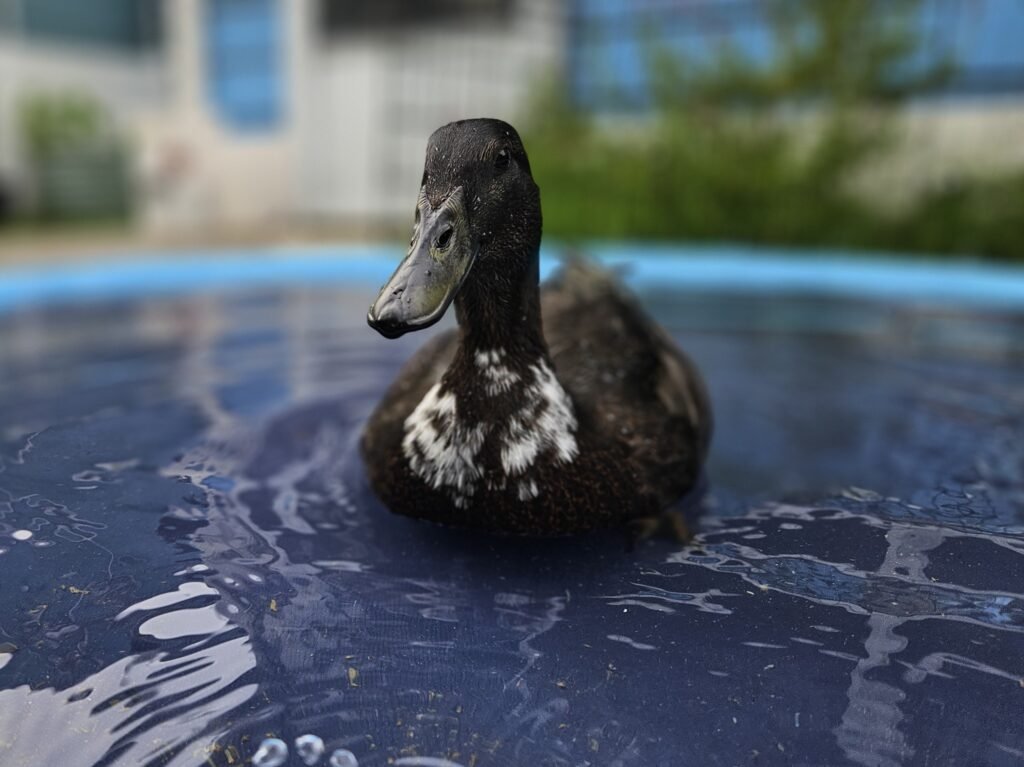
Molting Throughout Life: Seasonal and Age-Related Changes
Molting doesn’t stop after ducks reach adulthood. Healthy ducks will molt at least once per year, usually in late summer or early fall. This helps replace worn feathers and prepare for seasonal weather changes.
During a molt, you might notice:
- Patchy plumage
- Feathers of different lengths
- Duller or fresher colors
Certain breeds also change color with age:
- Cayugas often start solid black but develop increasing white mottling as they get older.
- Muscovies may show more or less barring and spotting over time.
- Ancona and Magpie ducks can gradually shift in patch size or symmetry with each molt.
📌 Pro-Tip: Don’t panic if your duck looks “off” during molt. Feathers take time to grow in evenly, and some temporary color shifts are completely normal.
Drake Molt: The Eclipse Phase
In wild-type and Mallard-derived breeds, drakes may enter an eclipse phase during summer, where they temporarily lose their vibrant coloring and resemble the females. This helps them stay camouflaged while they’re flightless during wing molt. The full drake plumage typically returns by fall.
Next up, we’ll talk about how color—and changes in color—can be signs of health issues or rare genetic conditions, like albinism or nutrient deficiencies.
Color and Health: What’s Normal and What’s Not
Most changes in your duck’s feather color are perfectly normal—part of growing up, molting, or seasonal transitions. But in some cases, color can also tell you something important about your duck’s health, genetics, or nutrition. Knowing what’s normal and what’s not can help you catch early signs of problems.
Genetic Color Variants: Albinism and Leucism
Occasionally, ducks hatch with rare genetic mutations that affect their ability to produce melanin, the pigment responsible for dark colors.
- Albinism
- True albino ducks lack melanin entirely.
- They have pink eyes, pale pink skin, and pure white feathers.
- This condition is extremely rare in ducks and is often associated with vision problems and higher sensitivity to sunlight.
- Leucism
- More common than albinism.
- Causes partial or total lack of pigment in feathers, but eyes remain normally colored.
- These ducks may appear white or patchy, but don’t have the full suite of albino traits.
- Some pied or unusually marked ducks may carry a mild form of leucism.
📌 Note: Leucism is sometimes mistaken for a breed trait (like Ancona or Magpie markings), but true leucistic birds often have unpredictable and asymmetrical patterns that persist or worsen with age.
Color Changes Due to Nutritional Deficiencies
Feather health is closely linked to nutrition, especially in growing ducklings and during molting. A lack of key nutrients can lead to:
- Dull or brittle feathers
- Loss of iridescence in black or green plumage
- Slow feather regrowth
- Color fading, especially in breeds with vibrant markings
Common deficiencies that affect feather color and quality:
| Nutrient | Role in Feather Health | Signs of Deficiency |
|---|---|---|
| Niacin (B3) | Supports growth and circulation | Weak legs, poor feathering |
| Methionine | Amino acid essential for feather production | Ragged feathers, slow regrowth |
| Biotin | Supports skin and feather quality | Dry, flaky skin, broken feathers |
| Vitamin A | Cell health and pigment metabolism | Pale or faded feathers |
| Copper | Helps produce melanin pigment | Washed-out color, especially in dark-feathered ducks |
A balanced feed formulated for ducks, plus healthy treats like leafy greens and occasional protein snacks (like grubs), can help prevent these issues. Avoid chicken layer feed long-term unless it meets duck-specific nutrient needs.
Stress, Hormones, and Environmental Triggers
Feather color can also shift temporarily in response to stress, illness, or environmental factors:
- Hormonal changes (like during laying or broody periods) may dull feather sheen
- Stress-induced molt can result in off-colored or patchy feathers
- Poor housing (like high ammonia or lack of bathing water) can lead to dirty, faded plumage
- Sun bleaching may lighten dark feathers over time, especially in ducks with outdoor access but limited shade
If your duck’s color change is sudden, patchy, or accompanied by other symptoms (lethargy, appetite loss, poor weight gain), it’s time to consult a vet.
When to Be Concerned
🚩 Red Flags to Watch For:
- Feather loss with no molt pattern
- Sudden color change without explanation
- Misshapen, frayed, or brittle feathers
- Flaking or inflamed skin underneath
- Other health signs (limping, labored breathing, inactivity)
📌 Pro-Tip: A healthy duck will have smooth, vibrant feathers—even if the colors change over time. Dullness, weakness, or unusual patterns may signal an issue.
Bonus Section: Other Inherited Traits Beyond Color
While this post focuses on color and pattern genetics, other physical traits in ducks are also inherited, sometimes in equally surprising ways. If you’ve ever hatched a duckling with a fluffy crest or noticed vastly different body types within the same clutch, genetics is again at play.
Let’s take a quick look at some of the other heritable traits duck keepers should be aware of:
Crested Heads
The famous “pom-pom” or crest is the result of a genetic mutation that causes a gap in the skull where fatty tissue and feathers grow outward.
- Inheritance:
- The crest gene is incompletely dominant. Breeding two crested ducks can be risky, as embryos with two copies of the gene (homozygous) often die before hatching or develop neurological issues.
- Best practice is to breed a crested × non-crested pair for safer outcomes.
- Surprise Factor:
- If only one parent appears crested, a duckling may still inherit a smaller or partial crest.
📌 Note: While adorable, crests are a genetic deformity and may lead to balance or coordination issues in some individuals.

Size and Build
- Body size and weight are influenced by multiple genes and are often breed-specific.
- Mixed-breed ducklings can have unpredictable size outcomes, especially when combining heavy and light breeds. You might end up with:
- Short, wide-bodied ducks
- Tall, lean ducks
- Or something entirely in between
Posture and Carriage
- Indian Runners are the best-known example here. They stand nearly vertical and walk with a unique upright posture.
- This posture is genetically inherited, and when crossed with horizontal-carrying breeds (like Khakis or Swedish), the result is a range of intermediate stances.
If you’ve hatched a duckling with “odd posture,” it may just be the expression of mixed-runner ancestry.
Voice and Behavior Traits
- Voice Sexing: In most breeds, females develop the classic loud “quack,” while males have a raspy whisper. This is sex-linked and usually noticeable by 6–8 weeks.
- Some Muscovy hybrids are quieter due to their Muscovy parentage, which can lead to unexpected vocal behavior.
- Temperament can also be inherited to a degree. Some breeds are naturally calm (like Welsh Harlequins), while others are more skittish or flighty.
In short, color is just the tip of the iceberg. When ducklings hatch, you’re rolling the dice on a wide range of inherited traits—including crest size, body shape, posture, and even personality. It’s part of what makes duck keeping such a fascinating experience!
Real-Life Example: Muffin the Mystery Duckling
One of the best examples of surprise duckling genetics in our own flock is Muffin—our sweet little mystery duckling who appeared out of nowhere and stole our hearts.
We found her by the pond behind our house on Easter Sunday, 2025. She was incredibly tiny, still had her egg tooth, and looked like she had just hatched. There were several wild and hybrid ducks nesting by the water that spring—Mallards, and Cayuga mixes. We believe Muffin was abandoned or separated from her mother, but somehow she found her way under the fence and right into our backyard. She stood in front of me, looking up as if to say, “Pick me up, Mom!”—so I did. And that’s how she joined our family.
Muffin’s Color: A Genetic Puzzle
Muffin’s coloring was striking from the start, and only became more intriguing as she grew.
- She is black with a bright white bib, similar to some Swedish markings.
- In certain lighting, her black feathers have a subtle mottled pattern, almost as if a second layer of color is hidden beneath the surface.
- Some areas, especially on her breast and belly, appear to have brownish undertones, suggesting incomplete black expression or possible chocolate/mallard pattern mixing.
These subtle shifts in color—depending on the angle of the light—are likely due to a mix of Extended Black (E) and other modifiers or recessive pattern genes. She may carry dilute genes or even dusky/mallard base genes that are partially masked.
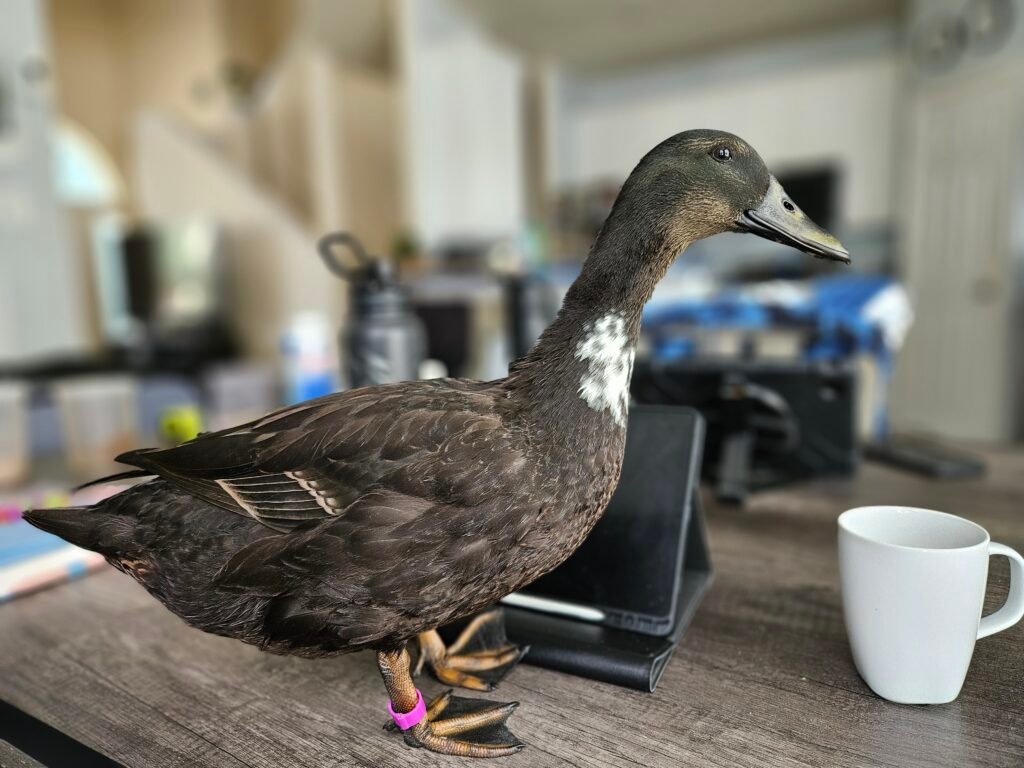
Size and Posture: More Mallard Than Muscovy
Muffin is noticeably smaller than most of our other ducks, and she carries herself with a light, horizontal posture, reminiscent of a wild-type Mallard. She also has excellent flight ability, and although she stays with our flock, she’s fully capable of taking off—something we’ve seen firsthand when she accidentally flew over the fence once (thankfully she came right back!).
Her build, agility, and body stance strongly suggest that at least one parent was a Mallard or Mallard-derived mix, which makes sense considering the resident population on our pond.
Likely Parentage: A Wild Mix of Backyard Genetics
The pond behind our house is home to:
- Mallards (both males and females, year-round)
- Cayuga hybrids, which are common in feral populations and often carry the dominant black gene
Muffin likely resulted from a cross between a black-based hybrid and a Mallard-type duck, both carrying a patchwork of hidden recessive traits. Her white bib, for instance, might come from a bibbed Swedish or Ancona ancestor, while her subtle mottling hints at complex pattern inheritance.
A Reminder That Genetics Isn’t Always Predictable
Muffin is the perfect example of why duck color genetics can be so surprising—and why observing and appreciating each duck’s uniqueness is so rewarding. Her story reminds us that even when we don’t know the exact parentage, we can often piece together clues from her color, shape, and behavior.
📌 Pro-Tip: If you live near a pond or have wild or hybrid ducks visiting, you might end up with ducklings that defy breed labels entirely—and that’s okay! Ducks like Muffin are wonderful little mysteries.
Final Thoughts: Embrace the Surprise!
When it comes to ducklings, surprises are part of the magic. Whether you’re a breeder hoping for specific traits or a backyard duck parent watching new babies hatch, there’s always a chance that genetics will throw you something unexpected, like Muffin.
Duck color genetics are complex, layered, and full of hidden variables. Between dominant and recessive genes, incomplete dominance, pattern modifiers, and breed-specific quirks, even experienced keepers are regularly amazed by the diversity that emerges in a single clutch of eggs.
But that’s what makes raising ducks so special. No two ducklings are ever exactly alike, and with every new hatch, you get to witness biology in action. The more you learn about the genetics behind color, size, posture, and other traits, the better you’ll understand and appreciate the beautiful birds in your flock.
So if a duckling hatches with an unexpected splash of white, a mysterious chocolate hue, or a crest you didn’t anticipate, know that you’ve just uncovered another layer of the fascinating story written into their DNA.
🐣 Your duck’s unique appearance is part of its charm—and a reminder that nature loves variety.

FAQs
Q: Can two white ducks produce a colored duckling?
A: Yes—if both ducks carry hidden recessive color genes, their offspring might not be white. Most white ducks have either the recessive white gene or a dominant white spotting gene, which can mask other colors. If the ducklings don’t inherit the white gene from both parents, those hidden colors may show through.
Q: Why is my duckling changing color as it grows?
A: It’s completely normal for ducklings to change color as they transition from down to juvenile and then to adult feathers. Many patterns and pigments only appear after the first or second molt. Some ducks also change color with age or due to seasonal molting.
Q: What does it mean if my black duck is turning white?
A: If your duck is a Cayuga or another black breed, this is likely part of the natural aging process. Cayugas, for example, often develop white speckling or mottling as they get older. If the change is sudden or uneven, check for nutritional deficiencies or stress-related molt.
Q: Can duck color affect their health?
A: The color itself doesn’t usually affect health, but feather condition can be a clue to overall well-being. Dull, brittle, or uneven feathering may indicate nutrient deficiencies, stress, or illness. True albinism is rare but can come with light sensitivity and vision problems.
Q: Can I predict duckling color by the color of the egg?
A: No—egg color (white, green, blue, etc.) is not linked to feather color. Eggshell color is determined by different genes altogether and is breed-specific. For example, Khaki Campbells lay white to pale green eggs, but their plumage is brown.
Related Articles
- Ultimate Duck Breed Comparison Guide: Find the Right Duck for Your Flock
- The Science Behind Duck Feathers: Anatomy, Function & Care
- Navigating Pet Duck Molting: A Owner’s Handbook
- Male vs Female Ducks Explained: From Bills to Behaviors

